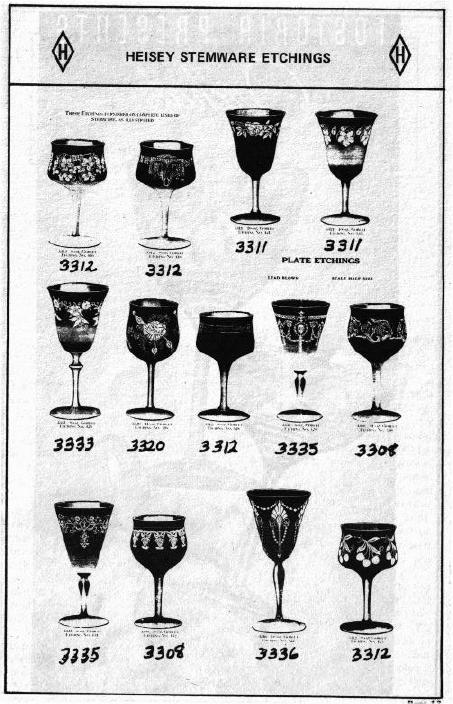National Depression Glass Association
Preserving America's Glass Manufacturing Heritage
Heisey's Early Stemware
by Clarence W. Vogel
Rainbow Review Glass Journal - June 1974
 According to some of the old Heisey workers, Heisey was principally
a pressed ware factory for the first twenty years of its production
period. The only blown ware made during this period were the oil
bottles made in blown molds. About 1910 Heisey began producing some
truly blown ware stems, No. 3302 and No. 3303 and others with pulled
stems. The stemware was made in many sizes to fit the type of liquid
being served. The largest was the goblet and the smallest was the
cordial. Those who have my Book IV may find a representation of these
early stems on pages 38 to 39 inclusive. The rest of you will have to
be satisfied with the plate furnished along with this composition.
According to some of the old Heisey workers, Heisey was principally
a pressed ware factory for the first twenty years of its production
period. The only blown ware made during this period were the oil
bottles made in blown molds. About 1910 Heisey began producing some
truly blown ware stems, No. 3302 and No. 3303 and others with pulled
stems. The stemware was made in many sizes to fit the type of liquid
being served. The largest was the goblet and the smallest was the
cordial. Those who have my Book IV may find a representation of these
early stems on pages 38 to 39 inclusive. The rest of you will have to
be satisfied with the plate furnished along with this composition.
Retired blowers, who worked for Heisey in the early days, informed me that Mr. A. H. Heisey, the founder of the Heisey Glass factory, was very reluctant about converting any production to blown ware. Mr. Heisey was of the old school of pressed ware glass makers, all of the patents being in that field. However, the demand of the market was changing and with the added pressure of his two sons, Edgar and Thomas, he capitulated to their wishes. But in the presence of the workers A. H. Heisey often shook his head in disapproval of the change.
On the illustration provided with this composition (below) are shown seven different stemware patterns of the early period. They are 3308, 3311, 3312, 3320, 3333, 3335, and 3336. Goblets 3333, 3335 and 3336 have applied stems. The remainder have pulled stems. A careful study of the individual goblets will show you why this is true. Remember too, that a change in the basic style or design of the bowl required a new pattern number. Stems 3335 and 3336 are known also as lady leg stems. The term lady leg was used by the blower and salesmen.
A stem mold was required for each of the applied stems shown. Pattern number 3333 is a clear example of this. In many instances a pressed stem was marked with the Diamond H. Pulled stems never carried the mark. It you have what you think is a pulled stem do not expect to find a mark on it. If you find a mark on it you have a pressed stem item. The Diamond H must be punched into the stem mold first, before it will transfer during the pressing procedure to the glass stem. It was impossible to get the Diamond H onto a strictly blown stem. A blown mold can be stamped with the Diamond H, but the mark may not always transfer well to the glass and further manipulation by the blower of the glass item, after being extracted from the blown mold, may obliterate the mark.
A substantial number of the early stemware made by Heisey are shown in my Books III and IV. The antique market is almost bare of most of them. In many instances, Heisey collectors do not recognize them as Heisey unless they carry the Diamond H mark. And dealers seem to be even worse. I hear many reports of collectors buying marked stemware from dealers and being advised by the dealer that it is unmarked Heisey, although the mark is there. Of course, it is well to remember that on stemware especially, the mark may be infinitesimally small.
From the first day that the blown ware shop went into production and until the close of the Heisey plant in December 1957, there was a continuous demand for blown ware. The beauty and clarity of a sparkling stem on a dinner table enhances all other decorative features. It has been said that the aristocratic southerners preferred Heisey stemware to all other Heisey glass. The southerners of the old south knew how to set a beautiful and appealing table.